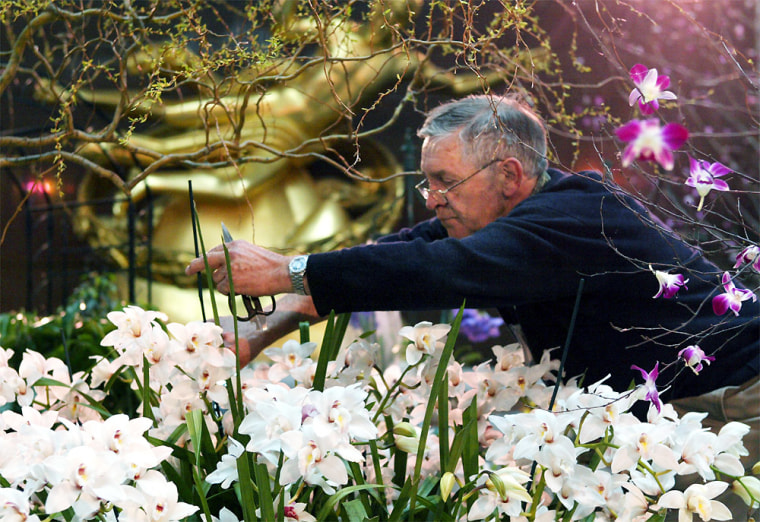Among the tens of thousands of orchids on display in the annual orchid show, the most precious is ugly and stinky.
The bulbophyllum phalaenopsis, with its 5-foot drooping leaves and blossoms reeking like rotten flesh, is featured at the 24th New York International Orchid Show that opened Wednesday at Rockefeller Plaza.
“It’s worth maybe $10,000, but you’ll never want to smell another orchid again,” American Orchid Society judge Bill Overton said with a laugh. “As they pass by, some people look at their shoes to see what they stepped in.”
By contrast, most of the 50,000-plus plants offered for show and for sale are the epitome of sheer beauty. Their exotic colors and shapes radiated beneath a translucent tent covering the exhibit, in the sunken space that in winter serves as the Rockefeller Center skating rink.
The exhibit, including orchid books, prints and jewelry, was flown in from around the United States, South America, Asia and Europe; the plants are pure species and artificially created hybrids.
Some hybrids do pop up in nature, "and you can tell because when you grow them, some look like their 'parent' plant, while others pick up the traits of ’grandma’ or other relatives," said Overton, who was among the judges rating the entries in the mammoth show, which runs through Sunday.
'Stinky' orchid wins ribbon
Just hours after the display opened, the “stinky” orchid had a ribbon tacked to it — representing the Certificate of Cultural Excellence for highest quality in its species, bestowed by the American Orchid Society.
Beauty is not the only measure of an orchid.
The revolting smell of the bulbophyllum phalaenopsis has a purpose in its native Indonesian jungle: reproduction. The orchid attracts flies by simulating the odor of maggots on rotting flesh. The flies feed on its blood-red blossom, then pollinate other orchids.
Reproduction is also the goal of the so-called “Bee Orchid,” whose blossom mimics the female bee. Real bees land on it, flying off with pollen stuck to their backs and dropping the seeds of new life into another orchid plant.
More romantic beginnings
But the most romantic orchid — at least, from the human perspective — is one commonly used for fancy corsages, the “Cattleya.”
Its story goes back to the 19th century, when English explorers brought back exotic plants from South America. They also came upon some unusual plants that were not in bloom — and perfect as padding for other tropical vegetation packed onto ships.
After the ocean voyage, the unusual plants blossomed into spectacular lavender flowers. Thus was born the corsage orchid, named after horticulturist William Cattley, whose gardener discovered the first one among some packing material.
Equally romantic is the story of Overton’s own passion for orchids, which started three decades ago when he was a newlywed and spotted the perfect orchid to bring home to his new wife.
“But it died, because I didn’t know how to take care of it,” Overton said. “Then I got a supermarket book on how to raise orchids.”
The conservation biologist now raises 1,800 orchid plants in the greenhouse of his home in Lynnebrook, on Long Island. And he’s become a master of the orchid’s mysteries.
“Orchids often flower better when they think they’re dying,” he said, explaining that “babying” an orchid by overwatering it often results in no blossoms.
“But when you leave it alone, and let it go through a ’lean’ stretch, it’ll think, ’It’s dying time, so I’d better make flowers to reproduce.”
